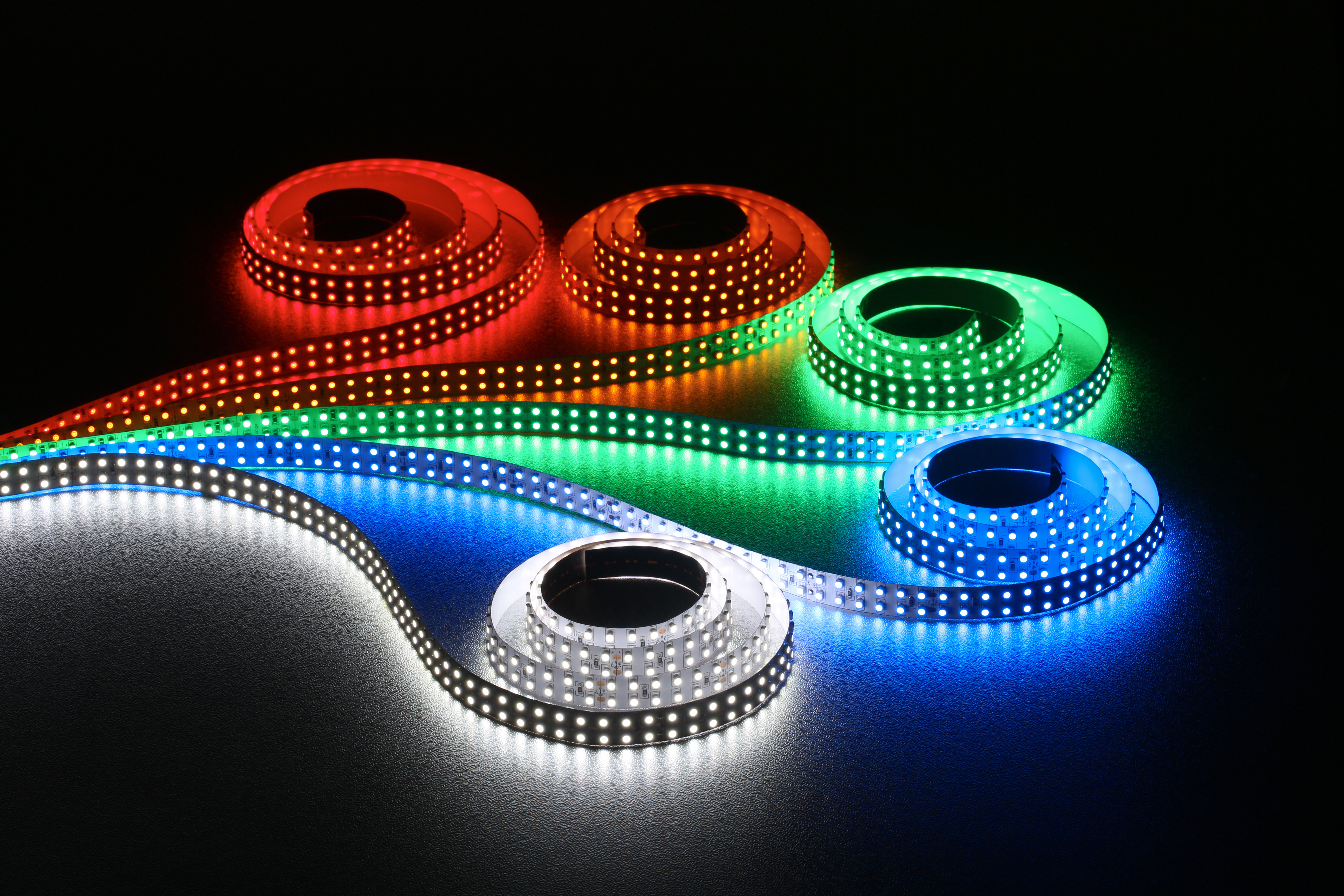Views: 0 Author: Site Editor Publish Time: 2025-03-20 Origin: Site
Ever wondered how long LED strip lights last? These versatile lighting options are used in homes, businesses, and outdoor spaces.
Understanding their lifespan helps with cost-efficiency and planning for replacements. Installation, maintenance, and environmental factors all play a role.
In this post, you’ll learn about the typical lifespan of LED strip lights and the factors that affect it.

Several factors impact how long LED strip lights last. Let's take a closer look at each of them.
Extreme temperatures can shorten the lifespan of LED strips. Both heat and cold can lead to faster degradation. Hot environments cause the LED components to overheat, reducing their efficiency. Cold conditions can also affect performance.
To help extend their lifespan, it's crucial to install LED strips in well-ventilated areas. Proper airflow prevents overheating and ensures longer-lasting performance.
The quality of the materials used in LED strips plays a significant role in how long they last. LED chips, resistors, and printed circuit boards (PCBs) directly affect longevity. Higher-quality materials allow for better performance and a longer lifespan.
Also, using high-quality power supplies and adhesives ensures that LED strips stay operational longer. Poor adhesives can degrade over time, while a low-quality power supply may cause voltage issues.
Inconsistent power supply or voltage fluctuations can be damaging. Voltage spikes or drops can burn out the components, causing the LEDs to dim or stop working.
Using the right power supply with stable voltage is crucial. It helps maintain optimal performance and avoids unnecessary wear and tear on the LED strips.
LED strip lights installed outdoors face different challenges than those used indoors. Outdoor strips are exposed to humidity, dust, and direct sunlight, which can significantly reduce their lifespan.
Indoor LEDs, on the other hand, are less exposed to harsh elements. However, it’s still important to consider the room's temperature and humidity when installing them.
How often and for how long you use LED strips matters. Constant use without breaks can lead to faster wear. LED strips used intermittently may last longer.
Additionally, turning LED strips on and off frequently can wear down the components. Consider using dimming controls or timers to reduce constant on/off cycles.

When it comes to understanding LED strip longevity, there are key metrics and testing standards to consider.
The L70, L80, and L90 metrics help estimate how long an LED strip will last before its light output diminishes by certain percentages.
L70 means the LED retains 70% of its original brightness after a set number of hours. This is the most common metric used.
L80 indicates the LED retains 80% of its brightness.
L90 shows the LED retains 90% of its original brightness.
These metrics provide practical insight into when an LED strip may start to appear dimmer or less effective for your needs.
To ensure accurate lifetime estimates, LEDs undergo LM-80 testing. This test measures the light output of LEDs over a specified period, typically 6,000 to 10,000 hours, to track lumen maintenance.
However, because testing for such long periods is impractical, TM-21 projections are used. This algorithm projects the LED's lifespan beyond the test period based on early performance data.
Manufacturers may sometimes overestimate LED lifespan due to testing limitations. For example, testing typically doesn’t exceed 6,000 or 10,000 hours, so manufacturers may claim longer lifespans, like 50,000 hours.
Additionally, some manufacturers may use higher-quality materials for testing samples but switch to cheaper materials in mass production. This can lead to inaccurate lifetime claims that don't reflect real-world performance.
Several other factors can impact the lifespan of LED strip lights, particularly when it comes to environmental protection and build quality.
IP ratings (Ingress Protection) indicate how well an LED strip is protected against dust and water. Common ratings include:
IP20: No protection against dust or water.
IP65: Dust-tight and protected against water jets, suitable for outdoor use.
The higher the IP rating, the better the protection against elements like moisture and dust. Waterproof LED strips, often used outdoors, have a shorter lifespan due to their inability to dissipate heat efficiently. The extra protective coatings can trap heat, which reduces the overall performance and longevity of the lights.
LED strips are built using different technologies, with SMT (Surface Mount Technology) and COB (Chip-on-Board) being the most common.
SMT: Traditional construction, where individual LEDs are mounted on a flexible circuit board. It’s cost-effective but can be less durable under stress.
COB: A newer method, where the LED chips are directly mounted on the board, providing better heat dissipation and increased durability.
The overall lifespan of LED strips depends heavily on the materials used for the PCB, resistors, and other components. High-quality materials ensure better heat management and longer-lasting performance.
Several issues can drastically reduce the lifespan of LED strip lights. These problems often stem from electrical or physical stress.
LED strips are sensitive to sudden voltage fluctuations. Voltage spikes or drops can cause irreparable damage, leading to dimming or complete failure.
Mechanical stress, like physical impacts or vibrations, also harms the strips. If LED strips are installed in areas subject to movement or shock, components may loosen or get damaged, reducing their lifespan.
Connecting LED strips with incorrect polarity can cause them to overheat. This overheating damages the internal circuits, shortening the strip's lifespan. Always double-check connections to ensure proper polarity.
The adhesive backing is vital for LED strip performance. Using poor-quality tape, like cheap alternatives, leads to weak adhesion. This can cause the strips to peel off or fail to conduct heat effectively.
High-quality adhesives, such as 3M VHB tape, ensure proper adhesion and prevent overheating. Poor adhesives can also break down faster in high-heat or vibration-prone areas, leading to premature failure.
Improper installation, poor maintenance, and other factors can all shorten the lifespan of your LED strip lights. Let’s look at some common issues.
To ensure a long lifespan, install your LED strips securely. Proper mounting prevents physical stress and damage. Using the right adhesives, like 3M VHB tape, helps the strips stay in place and ensures good thermal conductivity.
Always mount the strips in a stable position to avoid unnecessary strain or mechanical damage.
Heat is one of the main enemies of LED longevity. Ensure proper heat dissipation by installing aluminum heat sinks or ensuring the strips are in well-ventilated areas. Avoid placing LED strips in hot, enclosed spaces, as this can cause them to overheat.
Keep LED strips in cool, dry environments to avoid thermal damage.
Dust and dirt can build up on LED strips, affecting their performance. Regular cleaning removes debris that could block light output or cause the strips to overheat.
Use a soft cloth or gentle cleaning products to avoid damaging the strips during maintenance.
Dimming your LED strips can reduce stress on the components, helping them last longer. By using dimming controls or smart lighting systems, you can adjust brightness levels throughout the day, ensuring the LEDs aren’t overused.
Smart controllers can automatically adjust the brightness based on time of day, reducing wear and tear.
Not all LED strips are created equal. Opt for high-quality, reputable brands to ensure durability and performance. Look for certifications such as UL, CE, and LM-80 to ensure the product meets industry standards.
Choosing the right brand will provide better longevity and performance, saving you money in the long run.
LED strip lights don’t burn out like traditional bulbs. Instead, they gradually lose their brightness over time.
Unlike incandescent or fluorescent bulbs, which suddenly burn out, LED strip lights experience gradual dimming. As they age, their light output slowly decreases, often going unnoticed at first.
LED strips may also experience color shifting over time. The light color may shift as the LEDs degrade, affecting the quality of the light.
When LED strips become too dim, it’s time to replace them. You’ll notice a significant drop in brightness or color accuracy.
If your LED strips no longer provide enough light for their intended use, consider replacing them. Regular monitoring can help you determine when it’s time for a new set.
LED strip lights offer significant benefits, especially when compared to traditional lighting options.
Though LED strips may have a higher upfront cost, their long lifespan makes them a smart investment. Over time, they save money by reducing the need for frequent replacements.
Additionally, energy efficiency is a major advantage. LED strips use less electricity than incandescent or fluorescent lights, which lowers your monthly electricity bill.
LED lights are environmentally friendly. They have a lower carbon footprint and help reduce waste. Unlike incandescent and fluorescent bulbs, LED strips contain no harmful chemicals like mercury.
Choosing LEDs contributes to a more sustainable future. They consume less energy and last longer, making them a better option for reducing environmental impact.
When purchasing LED strip lights, understanding the packaging and specifications is essential to know what to expect from your lights.
Look for important lifespan metrics such as L70, LM80, and TM-21:
L70: This indicates that the LED will still provide 70% of its original brightness after a certain number of hours. It’s the most common lifespan rating.
LM80: This test measures how well LEDs maintain their light output over time, typically tested over 6,000 to 10,000 hours.
TM-21: This algorithm projects the expected lifespan of an LED based on initial test results, extending beyond the test period.
Certifications like UL, CE, and other third-party validations are crucial for quality assurance. They ensure the product meets safety and performance standards. Always look for these certifications to guarantee you’re purchasing a reliable product.
LED strips are durable, cost-effective, and long-lasting with proper maintenance. By choosing quality products and following key tips, you can maximize their lifespan. LED strip lights are energy-efficient, versatile, and perfect for various lighting needs, making them an excellent choice for your next project.
A: Look for signs like dimming or flickering. If the light output noticeably decreases, it may be time to replace the strips.
A: Proper installation, good maintenance, and using high-quality LED strips can significantly extend their lifespan. Keep them cool, clean, and avoid mechanical stress.
A: If damaged, LED strips may sometimes be repaired, but replacement is often more effective. Check if individual sections are faulty before deciding.
INTEGRATE™ is a series of integrate flexible LED strips including single White, single Color, variable white, RGB, RGB pixel, RGBW and RGBVW. Various types would meet any your customized requirements. Integrate has dome surface as COB for soft and dot-less effect, same SMD technology as lighting sou
Light and color have long been understood to influence human emotions, behavior, and even physical well-being. From the moment we wake up to the time we go to sleep, the type of light surrounding us plays a vital role in shaping our moods, productivity, and overall state of mind. This is why understanding the psychology of light and color is crucial when selecting LED lighting for various environments, whether it's at home, in the office, or in commercial settings.
LED strip lights are a popular choice for modern lighting due to their energy efficiency, versatility, and sleek design. However, one crucial aspect that is often overlooked when using LED strips is thermal management. LED lights, like any other electronic component, generate heat as they operate, and if not properly managed, this heat can reduce their performance and lifespan.
Choosing the right LED strip lights for your home or office is a decision that requires careful consideration. LED strips have become an increasingly popular choice due to their versatility, energy efficiency, and aesthetic appeal. However, with so many options available on the market, it’s easy to feel overwhelmed by the number of different types and features.
Indirect lighting has become a popular choice for creating a soothing and stylish ambiance in both residential and commercial spaces. Unlike direct lighting, which often creates harsh shadows and bright spots, indirect lighting provides a more gentle and even illumination that enhances the atmosphere without overwhelming the eyes.
Proper lighting on boats or yachts is not just about enhancing the aesthetic appeal; it plays a crucial role in ensuring safety, functionality, and comfort on the water. Effective lighting can help improve visibility during nighttime navigation, set the mood for evening activities, and highlight specific areas of your vessel. One of the best lighting options for marine environments is LED strip lights. Their versatility, energy efficiency, and durability make them an excellent choice for a variety of marine applications.
To ensure that your LED strip lights continue to perform at their best and last as long as possible, proper care and installation are essential. LED strips are known for their longevity and energy efficiency, but several factors can influence how long they last. By following some simple yet effective maintenance tips, you can extend the lifespan of your LED strips and keep them running smoothly for years to come.
When purchasing LED strip lights for your home or business, you might notice various certifications listed on the product packaging or technical specifications. These certifications, often represented by logos or marks, indicate that the product has met specific safety, environmental, and quality standards. Understanding what these certifications mean can help you make informed decisions, ensuring you choose a reliable and safe lighting solution.
LED strip lights are a fantastic way to add vibrant lighting to your home or workspace, offering versatility and energy efficiency. However, when it comes to installation, there are common mistakes that many people make, which can negatively affect the performance, lifespan, and overall functionality of the LED strips. Whether you're a seasoned DIYer or a first-time installer, it's crucial to avoid these common errors to ensure your LED lights shine brightly and last for years to come.
Flexible lighting strips, commonly known as LED strips or tape lights, have revolutionized the way we illuminate spaces. Their adaptability, energy efficiency, and vibrant lighting options make them popular choices for a wide variety of applications—from home decor to commercial advertising and industrial uses.
In recent years, flexible lighting strips have become increasingly popular not just for indoor use, but also as a creative and practical solution for outdoor lighting applications.
Flexible LED strip lights have rapidly gained popularity in both residential and commercial lighting applications. Their versatility, energy efficiency, and ease of installation make them an excellent choice for accent lighting, decorative purposes, and practical illumination alike.
Flexible lighting strips, commonly known as LED strip lights, are thin, versatile lighting fixtures that consist of small light-emitting diodes (LEDs) mounted on a flexible circuit board.
In the world of modern lighting, flexible lighting strips—also known as LED strip lights or ribbon lights—have revolutionized how we illuminate spaces. These thin, adaptable lighting solutions offer not only energy efficiency but also unmatched versatility, making them a top choice for a wide range of residential, commercial, and industrial applications.
Are you looking to enhance your space with vibrant lighting? LED Neon Flex is an energy-efficient, versatile, and durable solution that mimics traditional neon lights.
In the ever-evolving world of lighting, RGB Neon Flex Strip Light has emerged as a game-changer, offering a flexible, energy-efficient, and highly customizable alternative to traditional neon lighting.
Looking for a way to brighten up your space with vibrant lighting? Neon flex strip lights are a fantastic solution.
Have you ever wondered if you can cut neon flex strip light? This versatile lighting solution has become increasingly popular for custom projects.
COB LED strips are becoming an increasingly popular lighting solution, offering exceptional quality and performance.
Ever seen your wall paint or clothes look weird under certain lights? That's probably a low CRI at work. CRI affects how true colors look. It can make your home feel bright or dull. In this post, you'll learn what CRI means, why it matters, and which CRI is best for LED strips.


